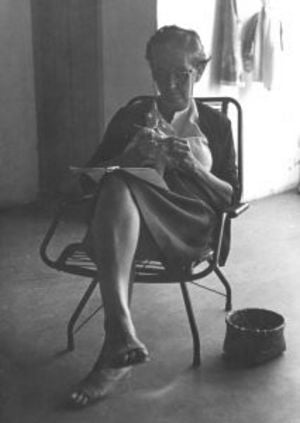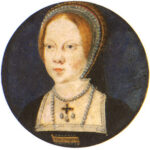Anne Bradstreet is perhaps one of the most well known American Puritans. Born Anne Dudley in Northampton, England in 1612, Bradstreet was one of the few women in American Puritan society that had been educated. Because of this education, Bradstreet faced a number of notable challenges when it came to maintaining her position in Puritan society. Despite these challenges however, Bradstreet became one of the most influential writers of all time; the scope and nature of her work transcending the most formidable cultural barriers. It is for this reason, that this investigation examines the specific events and circumstances that shaped the life of one of America’s most influential female writers.
Looking at Bradstreet’s personal life, it is evident that even though Bradstreet was born during an era in which even the most affluent of women were not sent to school, her father did believe in providing his children with an education. As such, Bradstreet was able to acquire her extensive knowledge of literature from eight tutors, employed by her father. Bradstreet subsequently brought her education to America as part of the Salem Puritan group. When Bradstreet first landed in the New World, she was shocked and dismayed by the suffering and poor living conditions that she faced. Despite these physical obstacles however, Bradstreet made a commitment to endure these hardships, believing that she would be better off in the United States than in England (Gonzales, “Anne Bradstreet”).
Although Bradstreet faced enormous challenges when it came to living in the New World, the challenges appear to have been trumped by the obstacles that she faced as a woman living in Puritan society. Bradstreet, because of her education, found it difficult to have her voice heard. Puritan women were consistently viewed as subservient to men. As such, when Bradstreet did share her work with others in the community, she often faced criticism from men in the community. According to one author, the profundity and insight provided in Bradstreet’s work led some men in the community to believe that Bradstreet had stolen her work from other male scholars. “Women were often considered intellectual inferiors and because of this, critics believed that Bradstreet stole her ideas for her poems from men. Her writing was severely criticized because it was that of a woman, receiving a different kind of criticism than that of her male counterparts” (Gonzales, “Anne Bradstreet”).
In addition to the fact that Bradstreet faced harsh criticism from male leaders of the Puritan society, researchers also note that Bradstreet faced notable criticism from society in general simply because of the nature of her work. As noted by one scholar, much of Bradstreet’s work focused on her love for her husband. In Puritan society, this love was supposed to be secondary to the individual’s love for God. As such, such expressions of love for one’s spouse were not viewed as appropriate for Puritan society. Despite the harsh criticism that Bradstreet received, it has been the enduring nature of the love that she describes in her writing that is seen as the reason for its transcendental appeal (Gonzales, “Anne Bradstreet”). Further, though her writing, Bradstreet was also able to elucidate the conflicts that she faced being a female writer during in Puritan society.
Other obstacles that faced Bradstreet when it came to her writing include the daily responsibilities of Puritan life. As noted by one author, Ann Bradstreet served as a mother to eight children, a wife, homemaker and hostess. Her household duties typically kept her busy from sun up to sun down (“Anne Bradstreet”). Despite the overwhelming amount of work that encompassed Bradstreet’s waking hours, she still found time to write. When Bradstreet published her first collection of writing, John Woodbridge, Bradstreet’s brother-in-law, “had to write…on the title page to assure readers that Bradstreet did not neglect her duties as a Puritan woman in order to write, by making it clear that she found time for her poetry by giving up sleep and using what little leisure time she had” (Gonzales, “Anne Bradstreet”). Although Bradstreet resented the implication that she was not a virtuous Puritan woman, she often did sacrifice sleep and leisure time to write.
Even though many of Bradstreet’s early writings and poems appear to reflect the depths of her resentment for women’s positions in Puritan society, scholars examining this authors work are quick to note that as Bradstreet matured, so too did her work. Specifically, one author makes the following observations, “Her later poems, written for her family, show her spiritual growth as she came fully to accept the Puritan creed. She also wrote more personal poems of considerable beauty, treating in them such subjects as her thoughts before childbirth and her response to the death of a grandchild” (“Anne Bradstreet”). What this effectively demonstrates is that as Bradstreet matured, the overall tone of her work began to change. As she embraced her faith more rigorously, her work began to assume a new spiritual dimension that is also a focal point of modern analysis and criticism.
When looking at Bradstreet’s works overall, what is perhaps most interesting about her modern day success is that when she first published her work in the seventeenth century, it was not that well received by the public. In an effort to better “fit in” with other writers of the day, Bradstreet “tried to incorporate the style of the male authors that she respected. By doing so she was limiting her abilities and denying her feelings” (Gonzales, “Anne Bradstreet”). It is for this reason that readers were not able to truly understand the depth of Bradstreet and her works until later in her career. Gonzales goes on to report that it was only after Bradstreet successfully published her first work that she garnered the confidence and experience to express her true feelings. In short, Bradstreet’s true writing style did not emerge until after she garnered success as a published author (Gonzales, “Anne Bradstreet”).
Overall Anne Bradstreet’s life is one that demonstrates the dichotomy faced by so many individuals that came to the New World. Although Bradstreet lived a life of privilege in England, her decision to journey to the New World placed her in a position that made her life much more difficult. Bradstreet faced the day-to-day challenges not only of living in the New World, but also of conforming to the social confines of the Puritan faith. Bradstreet had to balance her own personal desires for freedom and independence with the formal social structures imposed by Puritan society. Further, as an educated female, Bradstreet was one of the first women to challenge the stereotypes of women as intellectually inferior. Women in seventeenth century Puritan society were not expected to assert their independence or express the depth of emotion that was presented in many of Bradstreet’s works. In this context, it is quite evident that Bradstreet clearly challenged the status quo. Even though she faced notable criticism from both society and peers, her work was published. Fortunately, Bradstreet’s work has endured to provide modern scholars with a glimpse into the past.
In the end, Bradstreet’s work is important not only because it challenged the social status quo of the time period, but also because it provides modern readers with a more integral understanding of what life was like in seventeenth century Puritan society. Although Bradstreet’s early works clearly reflect the challenges facing women in Puritan society, her later works chronicle the spiritual journey that Bradstreet had made through her life. The range and depth of this work are important for understanding the profound changes that took place in the life of those traveling to the New World for the first time. Further, this work is important for demonstrating the notable obstacles that women had to overcome in order to garner any type of social equality. When examined in the perspective, the information provided in Bradstreet’s writings can be viewed as essential for understanding this time in history.
Works Cited
Anne Bradstreet.” American Literature on the Web. [2000]. Accessed August 9, 2006 at: http://www.nagasaki-gaigo.ac.jp/ishikawa/amlit/b/bradstreet1718.htm.
Gonzales, Ramon. Anne Bradstreet, 1612-1672.” University of North Carolina at Pembroke. [2000]. Accessed August 9, 2006 at: http://www.uncp.edu/home/canada/work/allam/16071783/lit/bradstre.htm.





